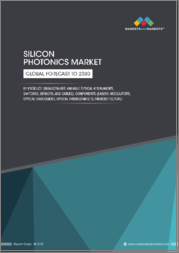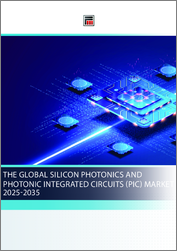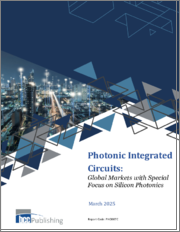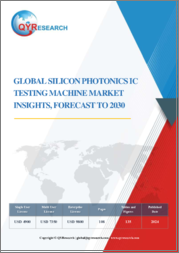
|
시장보고서
상품코드
1636713
실리콘 포토닉스 시장 예측(-2030년) : 구성요소별, 기술별, 용도별, 최종 사용자별, 지역별 세계 분석Silicon Photonics Market Forecasts to 2030 - Global Analysis By Component (Lasers, Modulators, Detectors, Waveguides, Photonic Integrated Circuits (ICs), Amplifiers and Other Components), Technology, Application, End User and By Geography |
||||||
Stratistics MRC에 따르면 세계의 실리콘 포토닉스 시장은 2024년에 22억 8,000만 달러를 차지했습니다. 예측 기간 동안 CAGR은 30.2%로 추정되며 2030년에는 82억 7,000만 달러에 이를 전망입니다.
실리콘 포토닉스는 실리콘을 매체로 빛을 조작하고 데이터 전송 및 데이터 처리를 수행하는 기술입니다. 실리콘 칩에 레이저, 변조기, 검출기 등의 포토닉 디바이스를 집적하여 고속 광통신 및 컴퓨팅을 가능하게 합니다. 실리콘 포토닉스는 실리콘의 반도체 특성의 장점을 활용하여 소형화 및 비용 효율적인 대량 생산을 가능하게 합니다. 데이터센터, 통신, 고성능 컴퓨팅에 널리 응용되고 있습니다.
2023년 조사에 따르면 전 세계 135개국에 총 6,603개의 데이터센터가 존재했습니다. 이 중 독일에는 310개, 프랑스에는 204개, 영국에는 345개, 스페인에는 97개 데이터센터가 있습니다.
고속 데이터 전송에 대한 수요 증가
통신, 데이터센터, 클라우드 컴퓨팅 등 업계에서 데이터 소비가 증가함에 따라 보다 빠르고 효율적인 통신 기술에 대한 요구가 커지고 있습니다. 기존의 전기 신호가 아닌 광학 기반 변속기를 활용하는 실리콘 포토닉스는 속도, 대역폭 및 에너지 효율 측면에서 큰 이점을 제공합니다. 데이터 전송 속도 가속화, 대기 시간 단축, 대용량 용도에서 성능 향상을 가능하게 하는 실리콘 포토닉스는 차세대 통신 시스템 개발을 지원하고 시장 확대에 박차를 가하고 있습니다.
제한된 재료 호환성
실리콘 포토닉스는 주로 실리콘에 의존하기 때문에 재료의 호환성이 제한적이며, 효율적인 빛의 발생 및 검출과 같은 특정 광학 기능에 필요한 다른 재료의 통합이 제한됩니다. 인화 인듐 및 갈륨 비소와 같은 재료와의 호환성 부족은 확장성, 기능성, 기존 시스템과의 통합에 영향을 미치고, 기술 혁신을 늦추고, 센서, 레이저, 고급 통신과 같은 응용 분야에서 실리콘 포토닉스 시장 성장을 방해합니다.
디바이스 소형화
디바이스의 소형화는 보다 빠르고 저전력으로 동작하는 보다 컴팩트하고 강력한 시스템을 가능하게 합니다. 데이터센터, 통신, 소비자 일렉트로닉스 등의 분야에서 광대역, 저지연 통신 수요가 높아짐에 따라, 소형화된 디바이스는 성능 향상과 소형화의 요구에 부응하고 있습니다. 이러한 발전은 전력 소비와 확장 성과 같은 문제를 해결하는 데 도움이되고 시장 확대를 뒷받침하고 실리콘 포토닉스를 현대 컴퓨팅 및 통신의 중요한 기술로 자리 매김하고 있습니다.
높은 초기 개발 비용
실리콘 포토닉스는 광학 부품과 실리콘 칩의 통합과 관련된 복잡한 제조 공정으로 인해 높은 초기 개발 비용이 필요합니다. 특수 제조 장비, 고급 재료, 숙련된 노동력이 필요하기 때문에 추가 비용이 듭니다. 또한 특정 용도로 실리콘 포토닉 디바이스를 설계 및 최적화하려면 많은 연구 개발 투자가 필요합니다. 이러한 고액의 초기 비용은 보급을 늦추고 시장 전체의 성장을 방해할 수 있습니다.
COVID-19의 영향
COVID-19 팬데믹은 실리콘 포토닉스 시장을 일시적으로 혼란시켜 공급망의 중단과 노동력 부족으로 제조, 연구개발 활동에 영향을 주었습니다. 그러나 팬데믹은 첨단 통신 시스템, 데이터센터, 의료 기술 수요를 가속화하고 실리콘 포토닉스의 장기 성장을 가속했습니다. 원격 근무으로의 이동과 클라우드 기반 서비스에 대한 의존도가 높아짐에 따라 고속 데이터 전송 솔루션에 대한 수요가 더욱 커졌습니다. 팬대믹 이후의 회복으로 이 분야에 대한 투자와 기술 발전이 부활하고 있습니다.
예측 기간 동안 액티브 실리콘 포토닉스 부문이 최대가 될 전망
액티브 실리콘 포토닉스 분야는 예측 기간 동안 최대 시장 점유율을 확보할 것으로 예측됩니다. 액티브 실리콘 포토닉스는 액티브 전자 디바이스와 포토닉 시스템을 통합하여 고속 데이터 전송, 프로세싱 및 센싱을 가능하게 하는 최첨단 분야입니다. 실리콘 기술과 포토닉스의 장점을 결합하여 이 분야는 통신, 데이터센터, 양자 컴퓨팅을 위한 솔루션을 제공합니다. 이 기술은 빠르고 효율적인 데이터 통신과 첨단 컴퓨팅이 필요한 산업에 혁명을 일으킬 잠재력을 가지고 있습니다.
예측 기간 동안 데이터센터 분야의 CAGR이 가장 높아질 전망
데이터센터 분야는 예측 기간 동안 가장 높은 CAGR이 예상됩니다. 데이터센터의 실리콘 포토닉스는 전기 신호 대신 빛을 이용한 빠르고 에너지 효율적인 데이터 전송을 가능하게 합니다. 이 기술은 서버와 스토리지 시스템 간의 상호 연결을 가속화하고 에너지 소비를 줄이고 전체 데이터센터 성능을 향상시킵니다. 또한 실리콘 포토닉스는 보다 컴팩트한 설계를 가능하게 하여 최신 데이터센터의 공간 및 전력 요구 사항을 줄이는 데 기여합니다.
최대 점유율 지역
아시아태평양은 데이터센터 확대, 5G 네트워크 채택 확대, 인공지능(AI) 및 머신러닝 용도의 등장으로 예측 기간 동안 최대 시장 점유율을 기록할 전망입니다. 중국, 일본, 한국과 같은 국가들은 반도체 제조 및 연구에서 주도하고 있으며 실리콘 포토닉스의 기술 혁신을 촉진하고 있습니다. 또한 정부의 이니셔티브와 R&D 투자는 시장 개척을 더욱 강화하고 있으며, 이 지역을 실리콘 포토닉스 세계의 거점으로 자리잡고 있습니다.
CAGR이 가장 높은 지역 :
북미는 데이터 통신, 고성능 컴퓨팅, 통신 분야의 기술 혁신과 발전에 힘을 쏟고 있기 때문에 예측 기간 동안 가장 높은 CAGR이 예상됩니다. 미국과 캐나다는 주요 기업이며, 특히 하이테크 대기업, 대학, 반도체 업체들이 연구 개발에 많은 투자를 하고 있습니다. 게다가 클라우드 컴퓨팅, 5G 네트워크, 데이터센터 채택이 확대되고 있는 것도 시장 확대를 더욱 뒷받침하고 있습니다.
무료 맞춤설정 제공 :
이 보고서를 구독하는 고객은 다음 무료 맞춤설정 옵션 중 하나를 사용할 수 있습니다.
- 기업 프로파일
- 추가 시장 기업의 종합적 프로파일링(3개사까지)
- 주요 기업의 SWOT 분석(3개사까지)
- 지역 세분화
- 고객의 관심에 응한 주요국 시장 추계·예측·CAGR(참고 : 타당성 확인에 따름)
- 경쟁 벤치마킹
- 제품 포트폴리오, 지리적 존재, 전략적 제휴에 기반한 주요 기업 벤치마킹
목차
제1장 주요 요약
제2장 서문
- 개요
- 이해관계자
- 조사 범위
- 조사 방법
- 데이터 마이닝
- 데이터 분석
- 데이터 검증
- 조사 접근
- 조사 정보원
- 1차 조사 정보원
- 2차 조사 정보원
- 전제조건
제3장 시장 동향 분석
- 성장 촉진요인
- 성장 억제요인
- 기회
- 위협
- 기술 분석
- 용도 분석
- 최종 사용자 분석
- 신흥 시장
- COVID-19의 영향
제4장 Porter's Five Forces 분석
- 공급기업의 협상력
- 구매자의 협상력
- 대체품의 위협
- 신규 참가업체의 위협
- 경쟁 기업간 경쟁 관계
제5장 세계의 실리콘 포토닉스 시장 : 구성요소별
- 레이저
- 변조기
- 감지기
- 도파관
- 포토닉 집적 회로(IC)
- 증폭기
- 기타 구성요소
제6장 세계의 실리콘 포토닉스 시장 : 기술별
- 액티브 실리콘 포토닉스
- 패시브 실리콘 포토닉스
제7장 세계의 실리콘 포토닉스 시장 : 용도별
- 광간섭 단층촬영(OCT)
- 테스트 및 측정
- 집적광회로
- 센싱
- 양자 컴퓨팅
- 광신호처리
- 자동화
- 기타 용도
제8장 세계의 실리콘 포토닉스 시장 : 최종 사용자별
- 통신 사업자
- 데이터센터
- 의료 및 의료 제공자
- 전자기기 제조업체
- 자동차회사
- 항공우주 및 방위조직
- 기타 최종 사용자
제9장 세계의 실리콘 포토닉스 시장 : 지역별
- 북미
- 미국
- 캐나다
- 멕시코
- 유럽
- 독일
- 영국
- 이탈리아
- 프랑스
- 스페인
- 기타 유럽
- 아시아태평양
- 일본
- 중국
- 인도
- 호주
- 뉴질랜드
- 한국
- 기타 아시아태평양
- 남미
- 아르헨티나
- 브라질
- 칠레
- 기타 남미
- 중동 및 아프리카
- 사우디아라비아
- 아랍에미리트(UAE)
- 카타르
- 남아프리카
- 기타 중동 및 아프리카
제10장 주요 발전
- 계약, 파트너십, 협업, 합작 투자
- 인수와 합병
- 신제품 발매
- 사업 확대
- 기타 주요 전략
제11장 기업 프로파일링
- Intel Corporation
- Cisco Systems Inc.
- IBM Corporation
- Juniper Networks Inc.
- Nokia Corporation
- Broadcom Inc.
- Lumentum Operations LLC
- SAMSUNG Electronics Corporation
- Apple Inc.
- STMicroelectronics
- Raytheon Technologies Corporation
- Infinera Corporation
- Finisar Corporation
- Analog Devices Inc.
- Lightwave Logic Inc.
- DustPhotonics
- Tower Semiconductor Limited
- GlobalFoundries Inc.
- Huawei Technologies Corporation
- Rockley Photonics
According to Stratistics MRC, the Global Silicon Photonics Market is accounted for $2.28 billion in 2024 and is expected to reach $8.27 billion by 2030 growing at a CAGR of 30.2% during the forecast period. Silicon photonics is a technology that uses silicon as a medium to manipulate light for data transmission and processing. It integrates photonic devices, such as lasers, modulators, and detectors, on a silicon chip, enabling high-speed optical communication and computing. Silicon photonics leverages the advantages of silicon's semiconductor properties, allowing for miniaturization and cost-effective mass production. It is widely applied in data centers, telecommunications, and high-performance computing.
According to a researcher's survey in 2023, there were a total of 6,603 data centers present among the listed 135 countries across the world. Among these, 310 data centers were present in Germany, 204 in France, 345 in the U.K., and 97 in Spain.
Market Dynamics:
Driver:
Increasing demand for high-speed data transmission
As data consumption rises across industries such as telecommunications, data centers, and cloud computing, the need for faster, more efficient communication technologies intensifies. Silicon photonics, which leverages light-based transmission rather than traditional electrical signals, offers significant advantages in terms of speed, bandwidth, and energy efficiency. By enabling faster data transfer rates, reduced latency, and improved performance in high-volume applications, silicon photonics supports the development of next-generation communication systems, fueling market expansion.
Restraint:
Limited materials compatibility
Silicon photonics has limited materials compatibility because it primarily relies on silicon, which restricts the integration of other materials needed for certain optical functionalities, such as efficient light generation or detection. The lack of compatibility with materials like indium phosphide or gallium arsenide affects scalability, functionality, and integration with existing systems, slowing innovation and hindering the market growth of silicon photonics in applications like sensors, lasers, and advanced telecommunications.
Opportunity:
Miniaturization of devices
The miniaturization of devices enables more compact, powerful systems that can operate at higher speeds and lower power consumption. As demand for high-bandwidth, low-latency communication in sectors like data centers, telecommunications, and consumer electronics rises, miniaturized devices meet the need for improved performance and reduced size. These advancements help address challenges like power consumption and scalability, propelling market expansion and positioning silicon photonics as a key technology in modern computing and communication.
Threat:
High initial development costs
Silicon photonics requires high initial development costs due to the complex fabrication processes involved in integrating optical components with silicon chips. The need for specialized manufacturing equipment, advanced materials, and skilled labor adds to the expenses. Additionally, designing and optimizing silicon photonic devices for specific applications demands significant research and development investment. These high upfront costs can slow down their adoption, thus hampering overall market growth.
Covid-19 Impact
The covid-19 pandemic temporarily disrupted the silicon photonics market, affecting manufacturing, research, and development activities due to supply chain interruptions and labor shortages. However, the pandemic also accelerated demand for advanced communication systems, data centers, and healthcare technologies, driving long-term growth in silicon photonics. The shift to remote work and increased reliance on cloud-based services further boosted demand for high-speed data transmission solutions. Post-pandemic recovery has led to resurgence in investment and technological advancements in this sector.
The active silicon photonics segment is expected to be the largest during the forecast period
The active silicon photonics segment is predicted to secure the largest market share throughout the forecast period. Active silicon photonics is a cutting-edge field that integrates active electronic devices with photonic systems to enable high-speed data transmission, processing, and sensing. By combining the benefits of silicon technology and photonics, this sector offers solutions for telecommunications, data centers, and quantum computing. This technology has the potential to revolutionize industries requiring fast, efficient data communication and advanced computing.
The data centers segment is expected to have the highest CAGR during the forecast period
The data centers segment is anticipated to witness the highest CAGR during the forecast period. Silicon photonics in data centers enables high-speed, energy-efficient data transmission using light instead of electrical signals. This technology allows faster interconnection between servers and storage systems, lowering energy consumption and enhancing overall data center performance. Silicon photonics also facilitates more compact designs, contributing to the reduction of space and power requirements in modern data centers.
Region with largest share:
Asia Pacific is expected to register the largest market share during the forecast period driven by the expansion of data centers, growing adoption of 5G networks, and the rise of artificial intelligence (AI) and machine learning applications. Countries like China, Japan, and South Korea are leading in semiconductor manufacturing and research, fostering innovation in silicon photonics. Additionally, government initiatives and investments in R&D further support market development, positioning the region as a global hub for silicon photonics advancements.
Region with highest CAGR:
North America is expected to witness the highest CAGR over the forecast period due to the region's strong focus on technological innovation and advancements in data communications, high-performance computing, and telecommunication sectors. The U.S. and Canada are key players, with significant investments in research and development, particularly from tech giants, universities, and semiconductor manufacturers. Additionally, the growing adoption of cloud computing, 5G networks, and data centers further drives market expansion.
Key players in the market
Some of the key players profiled in the Silicon Photonics Market include Intel Corporation, Cisco Systems Inc., IBM Corporation, Juniper Networks Inc., Nokia Corporation, Broadcom Inc., Lumentum Operations LLC, SAMSUNG Electronics Corporation, Apple Inc., STMicroelectronics, Raytheon Technologies Corporation, Infinera Corporation, Finisar Corporation, Analog Devices Inc., Lightwave Logic Inc., DustPhotonics, Tower Semiconductor Limited, GlobalFoundries Inc., Huawei Technologies Corporation and Rockley Photonics.
Key Developments:
In November 2024, Tower Semiconductor has introduced its 300mm Silicon Photonics process as a standard foundry offering, enhancing its 200mm platform. The larger wafer size increases compatibility with industry-standard platforms, simplifying integration with electronic components. This development provides a seamless transition for existing customers, positioning Tower to support growing demands in high-speed data communications.
In September 2024, DustPhotonics has unveiled an industry-first merchant 1.6Tb/s silicon photonics engine, targeting AI and hyperscale data center applications. This innovation promises to address the growing demand for high-speed, high-capacity interconnects in data centers and AI workloads, offering unprecedented bandwidth and low latency.
Components Covered:
- Lasers
- Modulators
- Detectors
- Waveguides
- Photonic Integrated Circuits (ICs)
- Amplifiers
- Other Components
Technologies Covered:
- Active Silicon Photonics
- Passive Silicon Photonics
Applications Covered:
- Optical Coherence Tomography (OCT)
- Test & Measurement
- Integrated Photonic Circuits
- Sensing
- Quantum Computing
- Optical Signal Processing
- Automation
- Other Applications
End Users Covered:
- Telecommunications Providers
- Data Centers
- Medical & Healthcare Providers
- Electronics Manufacturers
- Automotive Companies
- Aerospace & Defense Organizations
- Other End Users
Regions Covered:
- North America
- US
- Canada
- Mexico
- Europe
- Germany
- UK
- Italy
- France
- Spain
- Rest of Europe
- Asia Pacific
- Japan
- China
- India
- Australia
- New Zealand
- South Korea
- Rest of Asia Pacific
- South America
- Argentina
- Brazil
- Chile
- Rest of South America
- Middle East & Africa
- Saudi Arabia
- UAE
- Qatar
- South Africa
- Rest of Middle East & Africa
What our report offers:
- Market share assessments for the regional and country-level segments
- Strategic recommendations for the new entrants
- Covers Market data for the years 2022, 2023, 2024, 2026, and 2030
- Market Trends (Drivers, Constraints, Opportunities, Threats, Challenges, Investment Opportunities, and recommendations)
- Strategic recommendations in key business segments based on the market estimations
- Competitive landscaping mapping the key common trends
- Company profiling with detailed strategies, financials, and recent developments
- Supply chain trends mapping the latest technological advancements
Free Customization Offerings:
All the customers of this report will be entitled to receive one of the following free customization options:
- Company Profiling
- Comprehensive profiling of additional market players (up to 3)
- SWOT Analysis of key players (up to 3)
- Regional Segmentation
- Market estimations, Forecasts and CAGR of any prominent country as per the client's interest (Note: Depends on feasibility check)
- Competitive Benchmarking
- Benchmarking of key players based on product portfolio, geographical presence, and strategic alliances
Table of Contents
1 Executive Summary
2 Preface
- 2.1 Abstract
- 2.2 Stake Holders
- 2.3 Research Scope
- 2.4 Research Methodology
- 2.4.1 Data Mining
- 2.4.2 Data Analysis
- 2.4.3 Data Validation
- 2.4.4 Research Approach
- 2.5 Research Sources
- 2.5.1 Primary Research Sources
- 2.5.2 Secondary Research Sources
- 2.5.3 Assumptions
3 Market Trend Analysis
- 3.1 Introduction
- 3.2 Drivers
- 3.3 Restraints
- 3.4 Opportunities
- 3.5 Threats
- 3.6 Technology Analysis
- 3.7 Application Analysis
- 3.8 End User Analysis
- 3.9 Emerging Markets
- 3.10 Impact of Covid-19
4 Porters Five Force Analysis
- 4.1 Bargaining power of suppliers
- 4.2 Bargaining power of buyers
- 4.3 Threat of substitutes
- 4.4 Threat of new entrants
- 4.5 Competitive rivalry
5 Global Silicon Photonics Market, By Component
- 5.1 Introduction
- 5.2 Lasers
- 5.3 Modulators
- 5.4 Detectors
- 5.5 Waveguides
- 5.6 Photonic Integrated Circuits (ICs)
- 5.7 Amplifiers
- 5.8 Other Components
6 Global Silicon Photonics Market, By Technology
- 6.1 Introduction
- 6.2 Active Silicon Photonics
- 6.3 Passive Silicon Photonics
7 Global Silicon Photonics Market, By Application
- 7.1 Introduction
- 7.2 Optical Coherence Tomography (OCT)
- 7.3 Test & Measurement
- 7.4 Integrated Photonic Circuits
- 7.5 Sensing
- 7.6 Quantum Computing
- 7.7 Optical Signal Processing
- 7.8 Automation
- 7.9 Other Applications
8 Global Silicon Photonics Market, By End User
- 8.1 Introduction
- 8.2 Telecommunications Providers
- 8.3 Data Centers
- 8.4 Medical & Healthcare Providers
- 8.5 Electronics Manufacturers
- 8.6 Automotive Companies
- 8.7 Aerospace & Defense Organizations
- 8.8 Other End Users
9 Global Silicon Photonics Market, By Geography
- 9.1 Introduction
- 9.2 North America
- 9.2.1 US
- 9.2.2 Canada
- 9.2.3 Mexico
- 9.3 Europe
- 9.3.1 Germany
- 9.3.2 UK
- 9.3.3 Italy
- 9.3.4 France
- 9.3.5 Spain
- 9.3.6 Rest of Europe
- 9.4 Asia Pacific
- 9.4.1 Japan
- 9.4.2 China
- 9.4.3 India
- 9.4.4 Australia
- 9.4.5 New Zealand
- 9.4.6 South Korea
- 9.4.7 Rest of Asia Pacific
- 9.5 South America
- 9.5.1 Argentina
- 9.5.2 Brazil
- 9.5.3 Chile
- 9.5.4 Rest of South America
- 9.6 Middle East & Africa
- 9.6.1 Saudi Arabia
- 9.6.2 UAE
- 9.6.3 Qatar
- 9.6.4 South Africa
- 9.6.5 Rest of Middle East & Africa
10 Key Developments
- 10.1 Agreements, Partnerships, Collaborations and Joint Ventures
- 10.2 Acquisitions & Mergers
- 10.3 New Product Launch
- 10.4 Expansions
- 10.5 Other Key Strategies
11 Company Profiling
- 11.1 Intel Corporation
- 11.2 Cisco Systems Inc.
- 11.3 IBM Corporation
- 11.4 Juniper Networks Inc.
- 11.5 Nokia Corporation
- 11.6 Broadcom Inc.
- 11.7 Lumentum Operations LLC
- 11.8 SAMSUNG Electronics Corporation
- 11.9 Apple Inc.
- 11.10 STMicroelectronics
- 11.11 Raytheon Technologies Corporation
- 11.12 Infinera Corporation
- 11.13 Finisar Corporation
- 11.14 Analog Devices Inc.
- 11.15 Lightwave Logic Inc.
- 11.16 DustPhotonics
- 11.17 Tower Semiconductor Limited
- 11.18 GlobalFoundries Inc.
- 11.19 Huawei Technologies Corporation
- 11.20 Rockley Photonics



















